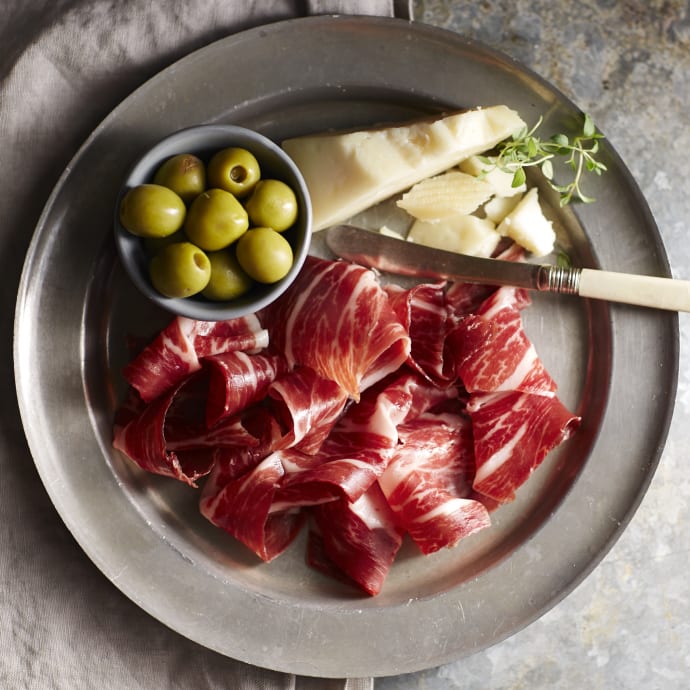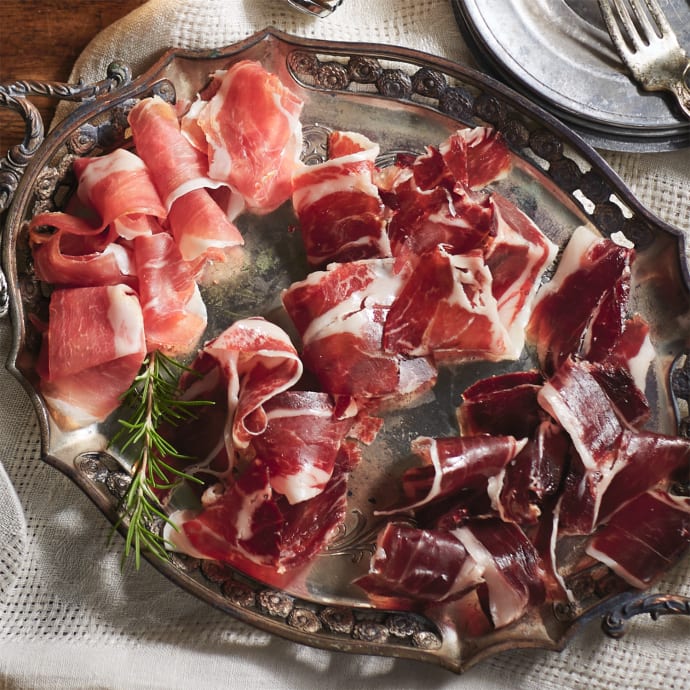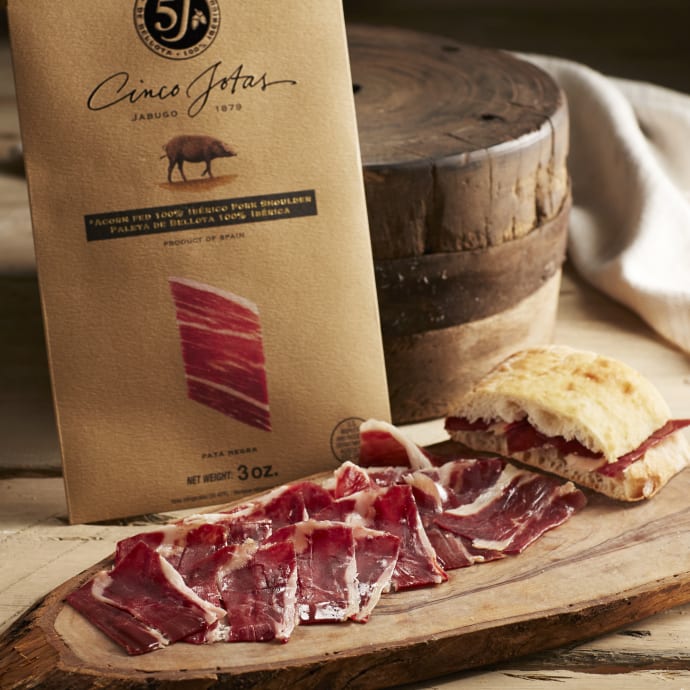
The Gastronomer: For bellota ham, nuts aren't the half of it
The Washington Post
-
February 24, 2010
Andreas Viestad
When it comes to the prized bellota ham from Spain, it is easy to understand why everyone talks about the nuts. As you approach Huelva, the Andalusian province most famous for those air-cured hams, the citrus groves of the semi-arid flatlands around Seville give way to oak-covered hills and mountains. Acorns, a staple in the menu of the local pigs, are said to be the secret behind the ham from the Iberian black-footed pigs, or pata negra, which many consider the best ham in the world.
The nuts are everywhere. They're in the name: Bellota means acorn. They're in the brochures advertising the product, on the labels that hang on the hams (which, unlike others, are sold with the hoof attached) and of course in the pasturelands in Huelva and the other bellota-producing areas of southwestern Spain.
Bellota ham is a relative newcomer to the American market, first imported here through a partnership involving chef-restaurateur José Andrés, and it is less marketable and much more expensive (more than $90 a pound at La Tienda) than such hams as Spanish serrano and Italian prosciutto di Parma. But it is all the more loved, by chefs and well-heeled food lovers alike. The bellota (or jamon iberico de bellota) does not lend itself to machine slicing; it should be served in smaller, slightly thicker slices. And it should be eaten within a few hours of slicing, so it is less suitable for convenient supermarket packaging. But what you get is truly unique: a ham that melts in your mouth, with a full, yet mild, almost cheesy character and a distinct nutty flavor. It is not really used in cooking; instead, the sliced pieces are served at the beginning of the meal and in some cases as the finishing garnish in dishes such as Spanish eggs.
The flavor is what most people are referring to when they talk about the bellota, and the general assumption is that you taste the acorns. That is wishful thinking more than anything else, a misleading myth that has made it impossible for other ham producers to duplicate the bellota's unique taste.
Many factors are important in the ham's production. While most pigs live a short life of confinement, often eating a monotonous and intensive diet, these pigs are allowed to roam freely over large areas. After the piglets are weaned, they are fed a limited amount of grain but are encouraged to find their own food in the wild. And they grow slowly. The pigs used in ham production are nearly 2 years old but weigh no more than a 9-to-12-month-old pig from a conventional commercial operation. For the last three to five months of their lives, they live exclusively on what they find in large, fenced oak groves, and the food could be mushrooms, grass, snails or whatever; the pigs are omnivorous.
I walked around one patch of land with Antonio Alfonso Esposito, an elderly pig herdsman who sported a bright-colored cardigan and a large umbrella, even though it was not raining. He told me that was a precaution, so he could be spotted easily from the nearby village. (His grandfather, also a pig herdsman, had been weakened by a stroke and fell down in the compound. The next day, only his rubber boots remained. That is unusual and hasn't happened since, my guide assured me.)
Acorns abound. When the herdsman shook a tree with his umbrella, a cascade of the nuts fell to the ground. Alerted by the sound, a pig approached, paying no attention to us, her sensitive snout soon finding all the acorns scattered around. And with every breath of wind: more acorns.
There is no doubt that this freedom and a healthful, naturally restricted diet do wonders for the quality of life of the pig, and consequently the quality of the meat. The hams are long and relatively lean, with a thin layer of fat on the outside and a good portion of intramuscular fat. Because of the high intake of fresh foods -- such as the still-green acorns -- and low portions of grains, the fat profile is also quite different, with a much higher percentage of mono- and polyunsaturated fatty acids, more similar to that of olive oil than to that of formula-fed pigs.
But the nuttiness that defines bellota is something else. Just as you cannot taste manure in an organic carrot, and grass-fed beef does not taste like grass, there is no one-to-one relationship between the nuts and the nuttiness in the ham, even though the producers seemingly want us to think otherwise.
If it were as easy as that, even I could do it. And I have tried. Inspired by my trip to Huelva and perhaps with a bit too much time on my hands on a winter sojourn in South Africa, I teamed up with one of my neighbors in the Elgin Valley, just outside Cape Town: Anthony Rawbone-Viljoen of Oak Valley Estates, who wanted to make a Spanish-style ham and who, as the name of his estate implies, has plenty of acorns for feed. The trial project was aided by Louw Hoffman, professor of meat sciences at Stellenbosch University.
In lieu of Iberian pigs, we decided to use Durocs, a hardy breed that is often interbred with Iberian pigs. The result, three years down the line -- after a bit of trial and error, tons of acorns and a significant effort from Rawbone-Viljoen -- is delicious, wonderfully marbled hams with great flavor that includes absolutely no trace of nuttiness. We had focused on the feed, but it became clear that acorns were not the source of the nutty flavor.
As part of an initial experiment, we did manage to make a really nutty ham. A few of the legs were cured in the garage of another Stellenbosch meat professor, Francois Mellett; he sometimes cures salamis and ham there for his own consumption. At first the garage seemed less than ideal: Situated in the seaside resort town of Kleinmund, it was too warm in summer, turned quite cold in winter and, with a spring running through it, was always quite humid. After six months or so the hams were completely covered with black mold, and as we entered the garage we sighed with disappointment: They were spoiled. But Mellett was ecstatic and encouraged us to smell the hams before giving up. And they smelled just fine; in fact, the whole garage was filled with much of the same sweet, nutty scent that had been present in the curing facilities in Huelva. After washing off the hams with a cloth, we sampled them, and I found the flavor to be the nuttiest I had ever tasted in a non-Spanish ham, reminiscent of a combination of bellota and Tuscan salami.
In fact, what Mellett had done was simply to hang the skin of a particularly good salami and a piece of bellota ham next to the hams, to inoculate them. Just as in cheesemaking or bread baking -- two of the most common fungus- and bacteria-based culinary activities -- time and the fungi had done their job, transforming the hams into something quite different from their delicious but frankly plain starting point, which was not much more than salty meat. The ham did not keep, though. Other molds must have been present, and after a few months the meat started developing other, less pleasant, flavors, including a strong ammonium taste that began to overpower the nuttiness. For the next batches of hams from Oak Valley, Rawbone-Viljoen and his team have stuck with more traditional dry-air curing.
In the past I had visited curing facilities in Parma and several other places, and a common thread was how dry and controlled everything seemed. In Huelva it was different, more like Mellett's garage. I arrived amid particularly unpleasant autumn weather that was cold and damp. Inside the screened but otherwise unprotected curing facilities it was more or less the same as outside. In summer, the day temperatures are scorching; at night it is cold. That lack of control over such crucial factors as humidity and temperature is an invitation for contamination and fungal attacks.
Here is the real secret of the bellota ham and its nutty flavor. The production is restricted to a few, mostly narrow, valleys in a relatively small area where the weather can be wet and wild. It seems an odd location in a country with an abundance of dry and stable climate conditions. But here in these valleys are found certain naturally occurring airborne fungi and bacteria that are now embedded in the curing sheds themselves. For months, in fact, the hams are completely covered in black fungus.
It is the unique fungal curing -- more like cheesemaking than conventional meat curing -- that makes bellota so unlike almost any other cured ham.
In fact, there are other pata negra hams, such as jamon iberico de pienso, from Iberian pigs that are cured similarly but raised almost exclusively on a grain-based diet. Although inferior in other ways, they have the same nutty flavor, without any of the mythology.
When it comes to the prized bellota ham from Spain, it is easy to understand why everyone talks about the nuts. As you approach Huelva, the Andalusian province most famous for those air-cured hams, the citrus groves of the semi-arid flatlands around Seville give way to oak-covered hills and mountains. Acorns, a staple in the menu of the local pigs, are said to be the secret behind the ham from the Iberian black-footed pigs, or pata negra, which many consider the best ham in the world.
The nuts are everywhere. They're in the name: Bellota means acorn. They're in the brochures advertising the product, on the labels that hang on the hams (which, unlike others, are sold with the hoof attached) and of course in the pasturelands in Huelva and the other bellota-producing areas of southwestern Spain.
Bellota ham is a relative newcomer to the American market, first imported here through a partnership involving chef-restaurateur José Andrés, and it is less marketable and much more expensive (more than $90 a pound at La Tienda) than such hams as Spanish serrano and Italian prosciutto di Parma. But it is all the more loved, by chefs and well-heeled food lovers alike. The bellota (or jamon iberico de bellota) does not lend itself to machine slicing; it should be served in smaller, slightly thicker slices. And it should be eaten within a few hours of slicing, so it is less suitable for convenient supermarket packaging. But what you get is truly unique: a ham that melts in your mouth, with a full, yet mild, almost cheesy character and a distinct nutty flavor. It is not really used in cooking; instead, the sliced pieces are served at the beginning of the meal and in some cases as the finishing garnish in dishes such as Spanish eggs.
The flavor is what most people are referring to when they talk about the bellota, and the general assumption is that you taste the acorns. That is wishful thinking more than anything else, a misleading myth that has made it impossible for other ham producers to duplicate the bellota's unique taste.
Many factors are important in the ham's production. While most pigs live a short life of confinement, often eating a monotonous and intensive diet, these pigs are allowed to roam freely over large areas. After the piglets are weaned, they are fed a limited amount of grain but are encouraged to find their own food in the wild. And they grow slowly. The pigs used in ham production are nearly 2 years old but weigh no more than a 9-to-12-month-old pig from a conventional commercial operation. For the last three to five months of their lives, they live exclusively on what they find in large, fenced oak groves, and the food could be mushrooms, grass, snails or whatever; the pigs are omnivorous.
I walked around one patch of land with Antonio Alfonso Esposito, an elderly pig herdsman who sported a bright-colored cardigan and a large umbrella, even though it was not raining. He told me that was a precaution, so he could be spotted easily from the nearby village. (His grandfather, also a pig herdsman, had been weakened by a stroke and fell down in the compound. The next day, only his rubber boots remained. That is unusual and hasn't happened since, my guide assured me.)
Acorns abound. When the herdsman shook a tree with his umbrella, a cascade of the nuts fell to the ground. Alerted by the sound, a pig approached, paying no attention to us, her sensitive snout soon finding all the acorns scattered around. And with every breath of wind: more acorns.
There is no doubt that this freedom and a healthful, naturally restricted diet do wonders for the quality of life of the pig, and consequently the quality of the meat. The hams are long and relatively lean, with a thin layer of fat on the outside and a good portion of intramuscular fat. Because of the high intake of fresh foods -- such as the still-green acorns -- and low portions of grains, the fat profile is also quite different, with a much higher percentage of mono- and polyunsaturated fatty acids, more similar to that of olive oil than to that of formula-fed pigs.
But the nuttiness that defines bellota is something else. Just as you cannot taste manure in an organic carrot, and grass-fed beef does not taste like grass, there is no one-to-one relationship between the nuts and the nuttiness in the ham, even though the producers seemingly want us to think otherwise.
If it were as easy as that, even I could do it. And I have tried. Inspired by my trip to Huelva and perhaps with a bit too much time on my hands on a winter sojourn in South Africa, I teamed up with one of my neighbors in the Elgin Valley, just outside Cape Town: Anthony Rawbone-Viljoen of Oak Valley Estates, who wanted to make a Spanish-style ham and who, as the name of his estate implies, has plenty of acorns for feed. The trial project was aided by Louw Hoffman, professor of meat sciences at Stellenbosch University.
In lieu of Iberian pigs, we decided to use Durocs, a hardy breed that is often interbred with Iberian pigs. The result, three years down the line -- after a bit of trial and error, tons of acorns and a significant effort from Rawbone-Viljoen -- is delicious, wonderfully marbled hams with great flavor that includes absolutely no trace of nuttiness. We had focused on the feed, but it became clear that acorns were not the source of the nutty flavor.
As part of an initial experiment, we did manage to make a really nutty ham. A few of the legs were cured in the garage of another Stellenbosch meat professor, Francois Mellett; he sometimes cures salamis and ham there for his own consumption. At first the garage seemed less than ideal: Situated in the seaside resort town of Kleinmund, it was too warm in summer, turned quite cold in winter and, with a spring running through it, was always quite humid. After six months or so the hams were completely covered with black mold, and as we entered the garage we sighed with disappointment: They were spoiled. But Mellett was ecstatic and encouraged us to smell the hams before giving up. And they smelled just fine; in fact, the whole garage was filled with much of the same sweet, nutty scent that had been present in the curing facilities in Huelva. After washing off the hams with a cloth, we sampled them, and I found the flavor to be the nuttiest I had ever tasted in a non-Spanish ham, reminiscent of a combination of bellota and Tuscan salami.
In fact, what Mellett had done was simply to hang the skin of a particularly good salami and a piece of bellota ham next to the hams, to inoculate them. Just as in cheesemaking or bread baking -- two of the most common fungus- and bacteria-based culinary activities -- time and the fungi had done their job, transforming the hams into something quite different from their delicious but frankly plain starting point, which was not much more than salty meat. The ham did not keep, though. Other molds must have been present, and after a few months the meat started developing other, less pleasant, flavors, including a strong ammonium taste that began to overpower the nuttiness. For the next batches of hams from Oak Valley, Rawbone-Viljoen and his team have stuck with more traditional dry-air curing.
In the past I had visited curing facilities in Parma and several other places, and a common thread was how dry and controlled everything seemed. In Huelva it was different, more like Mellett's garage. I arrived amid particularly unpleasant autumn weather that was cold and damp. Inside the screened but otherwise unprotected curing facilities it was more or less the same as outside. In summer, the day temperatures are scorching; at night it is cold. That lack of control over such crucial factors as humidity and temperature is an invitation for contamination and fungal attacks.
Here is the real secret of the bellota ham and its nutty flavor. The production is restricted to a few, mostly narrow, valleys in a relatively small area where the weather can be wet and wild. It seems an odd location in a country with an abundance of dry and stable climate conditions. But here in these valleys are found certain naturally occurring airborne fungi and bacteria that are now embedded in the curing sheds themselves. For months, in fact, the hams are completely covered in black fungus.
It is the unique fungal curing -- more like cheesemaking than conventional meat curing -- that makes bellota so unlike almost any other cured ham.
In fact, there are other pata negra hams, such as jamon iberico de pienso, from Iberian pigs that are cured similarly but raised almost exclusively on a grain-based diet. Although inferior in other ways, they have the same nutty flavor, without any of the mythology.
Other Press
What Andrew Zimmern Can’t Live Without
The Strategist
-
June 30, 2025
8 Tasty Ways To Travel The World With Food
Forbes
-
June 17, 2025
Holiday Gift Guide 2024: The Finest Spanish Olive Oils For A Taste Of Spain
Forbes
-
November 26, 2024
A trio of savory snacks to enjoy this fall
Atlanta Journal-Counstitution
-
November 1, 2024
Featured Products
 SHIPS FREE
SHIPS FREECinco Jotas Boneless 100% Ibérico de Bellota Jamón - FREE SHIPPING!
JM-107
(2)
$1,599.00$1,599.00
 SHIPS FREE
SHIPS FREECinco Jotas Bone-In 100% Ibérico de Bellota Jamón - FREE SHIPPING!
JM-106
(4)
$1,599.00$1,599.00
 BEST SELLER
BEST SELLERSliced Ibérico Ham by Peregrino, Nitrate Free - 2 oz
JM-23
(38)
$28.00$28.00
 BEST SELLER
BEST SELLERSliced Ibérico de Bellota Ham by Peregrino, Nitrate Free - 2 oz
JM-52
(47)
$42.00$42.00
 BEST SELLER
BEST SELLERJamón Tasting Trio of Sliced Ham
JM-25
(36)
$85.00$85.00
 BEST SELLER
BEST SELLERCured Meats of Spain Sampler
JM-45
(37)
$109.00$109.00
 BEST SELLER
BEST SELLERCinco Jotas Sliced 100% Ibérico de Bellota Shoulder - 3 oz
JM-111
(22)
$55.00$55.00







